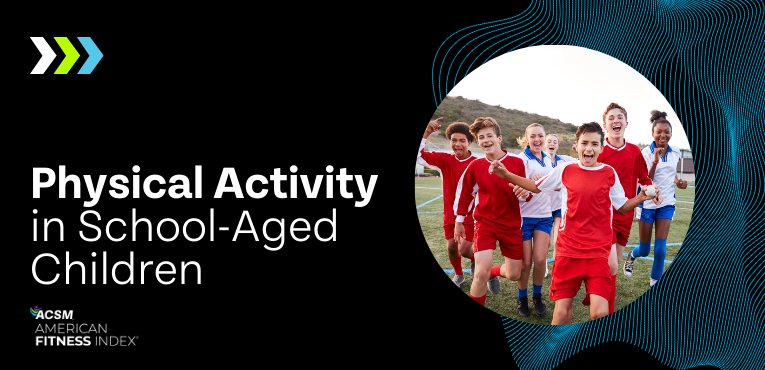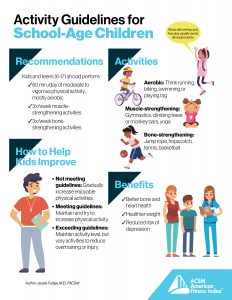Jessie Fudge, M.D., FACSM |
June
12, 2024
 School-aged children should get at least 60 minutes of moderate- or vigorous-intensity physical activity every day of the week. Only 26% of adolescents met these physical activity guidelines in 2018, and that percentage has remained stable since 2011.
School-aged children should get at least 60 minutes of moderate- or vigorous-intensity physical activity every day of the week. Only 26% of adolescents met these physical activity guidelines in 2018, and that percentage has remained stable since 2011.
The COVID-19 pandemic made it even more difficult for children to meet these guidelines. At the start of the pandemic, my son switched to online school, and the community park was blocked off with bright-yellow caution tape. Despite knowing the risk of sedentary behavior and decreased physical activity, we found our kids were less likely to engage in free play without friends, parks and school.
The rate of increase in body mass index (BMI) in children 2-19 years of age nearly doubled during the COVID-19 pandemic compared to pre-pandemic rates. This faster increase in BMI was most pronounced in children who were already overweight, and in younger school-aged children. The number of children and teens classified as obese increased from 19% pre-pandemic to 22% at the time of publication.
The COVID-19 pandemic shut down schools, sports, after-school programs and community parks. In addition to disruptions in physical activity opportunities, there was also loss of income, increased food insecurity, increased stress and increased screen time. Despite the return of school and community-based programs, sports participation has not rebounded back to pre-pandemic levels. BMI changes during the COVID-19 pandemic highlight the importance schools play in the health of our children and the community.
 Physically active children have lower rates of obesity in childhood, and a lower risk of obesity and chronic medical conditions in adulthood. In addition, higher levels of physical activity improve cognition, executive function, attention and academic performance. Increasing physical activity in schools through daily recess, physically active classroom lessons, longer or more frequent physical education classes and before- and after-school activities helps children reach physical activity guidelines and build the foundation of a healthy lifestyle into adulthood.
Physically active children have lower rates of obesity in childhood, and a lower risk of obesity and chronic medical conditions in adulthood. In addition, higher levels of physical activity improve cognition, executive function, attention and academic performance. Increasing physical activity in schools through daily recess, physically active classroom lessons, longer or more frequent physical education classes and before- and after-school activities helps children reach physical activity guidelines and build the foundation of a healthy lifestyle into adulthood.
Fortunately, 93 of the 100 largest U.S. cities (listed in the ACSM American Fitness Index®) are located in states that require physical education* in elementary, middle and high school. This ensures millions of children learn how to be physically active for a lifetime. Families should also be encouraged to stay active as a family, provide opportunities for free play, participate in active transportation and limit screen time. My kids were happier, slept better and were more engaged when the parks opened back up, they went back to school and they had much less computer time.
The extra time needed to increase physical activity both in school and after school is easily made up for with improved concentration, attention span and academic performance. Utilizing school-based physical activity programs has never been more important!
Download the infographic.
Author: Jessie Fudge, M.D., FACSM, Kaiser Permanente Washington
Originally published on August 18, 2022
*The Fitness Index’s physical education indicator is based on state-level policies requiring a minimum amount of physical education for all schools in the state. Policies are coded 0-3 depending on the amount of physical education required. States requiring physical education at all three grade levels (elementary, middle, and high school) are given the highest score. Two states represented in the Fitness Index were coded zero for having no state policy requiring physical education: Colorado and Hawaii.